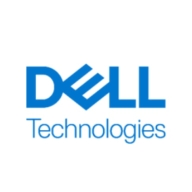

Dell PowerProtect DD and NetApp FAS Series compete in the data storage and protection market. Dell seems to have the upper hand with its advanced deduplication and compression features, while NetApp excels in virtualization and data management.
Features: Dell PowerProtect DD focuses on advanced deduplication and compression, optimal for space savings and quick backups. It integrates well with various software, enhancing its functionality. NetApp FAS Series offers multi-protocol support, robust storage solutions, and powerful snapshot and FlexClone capabilities, tailored for extensive environments.
Room for Improvement: Dell PowerProtect DD could improve in licensing complexity, pricing, cloud technology integration, and real-time online backup. Cloud and ransomware protection features are also areas for enhancement. NetApp FAS Series has challenges with pricing, flash support infrastructure, scalability, and cloud integration, along with the need for better snapshot management.
Ease of Deployment and Customer Service: Dell PowerProtect DD is mainly deployed on-premises, with some hybrid and cloud instances, and provides robust technical support though responsiveness may vary by region. NetApp FAS Series is similarly deployed with effective customer service, albeit with user feedback indicating a need for easier integration and setup configurations. Dell is noted for its swift service response, while NetApp is praised for network integration ease.
Pricing and ROI: Dell PowerProtect DD is perceived as high-priced but justified by its deduplication features and strong ROI through efficient storage and backup solutions. Users see it as a comprehensive solution reducing the need for additional tools. NetApp FAS Series has variable pricing based on customization, potentially costly for some but offering considerable value through features and reliability. Concerns about NetApp's cost exist, while Dell's offering remains attractive for enterprise-level needs.
If you have the configuration well maintained and configured, you should have good efficiency and compression for the clients and for yourself.
They respond within 24 hours of case submission, which is crucial for maintaining the solution.
I have dedicated support from Dell for Vietnam, and they are responsive.
I have encountered an issue before with other brands that would not have occurred with Dell.
Sometimes, the support was inadequate because the initial architecture was poorly defined.
We are also using it ourselves for the SAN and CIFS protocol.
They often provide basic solutions, such as suggesting a failover or a power cycle, which are not the sophisticated solutions we expect from a vendor.
The scalability depends on the IT department's strategy.
By keeping the increasing data in mind, we decided to go for Data Domain.
The solution is scalable to higher models, both vertically and horizontally.
We normally avoid current versions and use versions that have been running for at least two months in client usage before updating drivers.
NetApp FAS Series is scalable, and it is possible, but you need to pay.
The NetApp FAS Series is scalable and offers numerous solutions, but only if customers are willing to invest in the shelves.
Dell is especially more stable in the enterprise product.
Dell PowerProtect DD (Data Domain) is stable in terms of software performance.
When panic occurs on the node, it reboots itself, and we have experienced numerous hardware-related issues.
Most things are tailor-made, and we avoid downtimes even with primitive CLI commands.
The high availability feature is only present in the higher models of Dell PowerProtect DD (Data Domain).
It is suitable for more customers since it is small, cost-effective, and a good start for any customer to know about Data Domain and DBS solutions.
Medium-level and SME-level businesses can easily utilize this feature, but Dell PowerProtect DD (Data Domain) is a relatively expensive solution to propose to customers.
Storage companies should create encrypted storage solutions between the OS and storage to protect against ransomware attacks.
Nutanix leads the business in this approach, and I feel that NetApp is missing some aspects, such as CPU, GPU, and RAM, in its AI portfolio.
There is an opportunity there for NetApp with Cloud Volumes ONTAP.
It is almost four times the earlier price.
The pricing has become higher since July, and the license costs are more expensive compared to the past.
The price for PowerProtect DD is not suitable for my customers. It is very high.
The pricing of NetApp FAS Series is not cheap, but in comparison to other vendors, NetApp FAS Series is affordable.
The most valuable feature of Dell PowerProtect DD (Data Domain) is its deduplication capability.
Dell PowerProtect DD (Data Domain) is highly consistent, durable, easy to install, scalable, and compatible with any software today.
By using Data Domain, we get the advantage of data deduplication, reducing data size.
While NVMe disks are expensive and require three disks for parity calculations, hard drives in NetApp FAS Series are inexpensive, making it more cost-efficient per GB, even with RAID tech implementation.
Our IOPS are very high, reaching somewhere about 50k to 150k or 1.150k.
One important feature for customers is its ease of use and continuity, enabling seamless usage across on-premise and cloud environments.
| Product | Market Share (%) |
|---|---|
| Dell PowerProtect DD (Data Domain) | 27.2% |
| NetApp FAS Series | 3.7% |
| Other | 69.1% |


| Company Size | Count |
|---|---|
| Small Business | 32 |
| Midsize Enterprise | 21 |
| Large Enterprise | 32 |
| Company Size | Count |
|---|---|
| Small Business | 31 |
| Midsize Enterprise | 37 |
| Large Enterprise | 57 |
Dell PowerProtect DD (Data Domain) is a trusted backup appliance, offering advanced data protection through efficient deduplication and compression technologies, ensuring seamless integration and cyber resilience.
Built for both traditional and modern workloads, Dell PowerProtect DD provides a powerful backup solution with reliable protection, high performance, and reduced operational risk. It streamlines backup processes while enhancing data capacity and security through features like DD Boost and multi-platform compatibility. Users benefit from its robust ransomware defense and encryption capabilities. Despite challenges like high pricing and complex setups, it integrates effectively with backup software and offers capabilities such as efficient deduplication, data compression, and multi-site data replication.
What are some key features of Dell PowerProtect DD?Dell PowerProtect DD plays a vital role in sectors like banking, healthcare, and enterprise environments, supporting critical workload protection and seamless data recovery. It integrates with systems like NetWorker and Veeam for efficient operations, proving essential in environments where multi-site data replication is crucial.
NetApp FAS series is an enterprise-level storage system that provides a wide variety of data management services, including data protection, block and file storage, and data management.
NetApp FAS is designed to be highly scalable, allowing your organization to grow storage capacity on demand. NetApp FAS also supports multiple protocols, including NFS, SMB, iSCSI, and Fibre Channel, as well as various storage architectures, including SAN (Storage Area Network) and NAS (Network-Attached Storage).
The FAS series has multiple data protection and data management features, including snapshots, cloning, replication, and deduplication, to help secure your data and manage it more efficiently. The system integrates with other NetApp products and solutions, to create a unified data management platform. The system can be deployed on-premise, on multi-cloud environments, or hybrid.
NetApp FAS Series Benefits and Features
NetApp FAS series provides its users with several key benefits and features, including:
Reviews from Real Users
NetApp FAS Series stands out among its competitors for a number of reasons. Several major ones are its speed, reliability, and a wide variety of features.
Adriano S., IT project and infrastructure service manager, writes, “The replication feature is noteworthy because it's faster than most and it uses little bandwidth. Then there's the friendly interface that the equipment offers. With this interface, it is very easy to manage.”
Temitope O., a NetApp product manager at Hiperdist Ltd, says, “I like the unified management feature because sometimes you end up running a single protocol on the entire system. You rather have a system for a particular protocol and another system for other protocols, especially in a big environment like mine.”
We monitor all Deduplication Software reviews to prevent fraudulent reviews and keep review quality high. We do not post reviews by company employees or direct competitors. We validate each review for authenticity via cross-reference with LinkedIn, and personal follow-up with the reviewer when necessary.